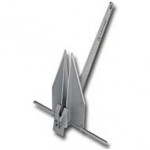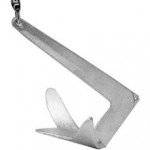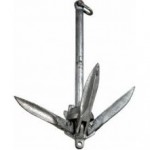Anchoring – Which Anchor is Right for My Boat?
Source: americanboating.org & Mariners Learning System, By Captain Bob Figular
There are different types of anchors with specific advantages and disadvantages depending on various factors. The type of anchor and size (weight) of anchor a boat uses basically depends upon the size of the boat, bottom characteristics of the anchorage, time at anchor and weather. It is advisable for coastal cruising sailors and power boaters to carry at least two anchors of different designs. The first would be your primary anchor that should have the holding power to equal to approximately 6% of the boat’s displacement. The second being a storm anchor should be at least 150-200% as effective as the service anchor. Some cruisers carry a lighter third anchor that is considered their lunch hook that is used in light winds and for short periods of anchoring.
In this posting we are going to review several different types of anchors focusing on their strengths and weaknesses and practical uses.
The fluke style uses a stock at the crown to which two large flat surfaces are attached. The stock is hinged so the flukes can orient toward the bottom (and on some designs may be adjusted for an optimal angle depending on the bottom type.) The design is a burying variety, and once well-set can develop an amazing amount of resistance. Its lightweight and compact flat design make it easy to retrieve and relatively easy to store; some anchor rollers and hawse pipes can accommodate a fluke-style anchor. The fluke style anchor is known to hold best in sand and soft mud but this style anchor does not hold as well on rocky, grassy, clay, or weed bottoms.

The plow anchor as the name implies, are shaped like a farmer’s plow, with a long shank ending in two curved flukes. They perform well in sand, gravel, rocks, and coral, but not so well in soft mud or clay, where their smaller surface area may not provide adequate resistance. The three most popular makes are the C.Q.R., the Delta and the Bruce. All stow well in a bow roller, which is just as well because they’re very awkward to stow anywhere else. The C.Q.R. (a poor pun on the word secure) is made of hand-forged steel and has a lifetime warranty against breakage. It features a hinged shank; therefore, it will not be unseated by small changes in the direction of pull. The Delta, a newer design, lacks the hinged neck of the C.Q.R. and is less expensive. It is otherwise very similar and may be slightly superior in holding power. It will launch itself from a bow roller as soon as you release tension on the rode, and its weighted tip makes it roll over into the dig-in position as soon as it hits the bottom. The Bruce is a modified plow that is more of a winged scoop.

The claw anchor utilizes a high–strength one–piece design. This style anchor sets quickly and is considered reliable in most seabeds and is know to reset well. Claw anchors hold in most bottom types and varying conditions but is best in rock, weed, and coral. It is known to have limited holding power in mud or soft sand.
Other anchor styles include the fisherman and four-pronged grapnel style anchors. The fisherman design is a non-burying type, with one arm penetrating the seabed and the other standing proud. It has a good reputation for use in rock, kelp and grass but needs to be much heavier than an equivalent Plow or fluke style anchor.

